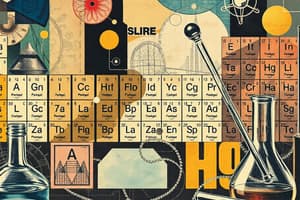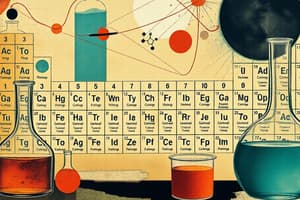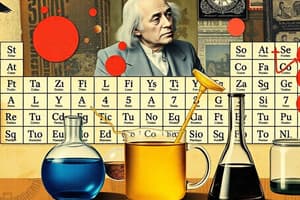Podcast
Questions and Answers
Which type of bond is formed by the transfer of electrons from one atom to another?
Which type of bond is formed by the transfer of electrons from one atom to another?
- Metallic Bond
- Ionic Bond (correct)
- Hydrogen Bond
- Covalent Bond
All substances with a pH greater than 7 are considered acids.
All substances with a pH greater than 7 are considered acids.
False (B)
What is the term used for the mass of one mole of a substance in grams?
What is the term used for the mass of one mole of a substance in grams?
Molar mass
The process of breaking down compounds into simpler substances is called ________.
The process of breaking down compounds into simpler substances is called ________.
Match the following types of reactions with their descriptions:
Match the following types of reactions with their descriptions:
Which of the following factors can affect the rate of a chemical reaction?
Which of the following factors can affect the rate of a chemical reaction?
Dynamic equilibrium occurs when the rate of the forward reaction is greater than the rate of the reverse reaction.
Dynamic equilibrium occurs when the rate of the forward reaction is greater than the rate of the reverse reaction.
What is the process called when a system at equilibrium shifts to counteract a disturbance?
What is the process called when a system at equilibrium shifts to counteract a disturbance?
Salts are formed by the reaction of an acid and a ______.
Salts are formed by the reaction of an acid and a ______.
Match the following organic compounds with their characteristics:
Match the following organic compounds with their characteristics:
Flashcards are hidden until you start studying
Study Notes
Basic Concepts
-
Matter: Anything that has mass and occupies space.
- States of Matter: Solid, Liquid, Gas, Plasma.
-
Atoms: Basic unit of matter.
- Components: Protons (positive), Neutrons (neutral), Electrons (negative).
-
Elements: Pure substances consisting of only one type of atom.
- Represented by symbols (e.g., H for Hydrogen).
Periodic Table
- Arrangement: Elements organized by increasing atomic number.
- Groups: Vertical columns with similar chemical properties.
- Periods: Horizontal rows indicating energy levels.
Chemical Bonds
- Ionic Bonds: Formed by the transfer of electrons from one atom to another.
- Covalent Bonds: Formed by sharing electrons between atoms.
- Metallic Bonds: Result from the sharing of free electrons among a lattice of metal atoms.
Chemical Reactions
- Reactants and Products: Substances that undergo change (reactants) and the result of the change (products).
- Types of Reactions:
- Synthesis: Combining elements to form compounds.
- Decomposition: Breaking down compounds into simpler substances.
- Single Replacement: One element replaces another in a compound.
- Double Replacement: Exchange of ions between two compounds.
- Combustion: Reaction with oxygen producing heat and light.
Stoichiometry
- Mole Concept: A mole is 6.022 x 10²³ particles (Avogadro's number).
- Molar Mass: The mass of one mole of a substance in grams.
- Balanced Equations: Number of atoms must be the same on both sides of the equation.
Acids and Bases
- Acids: Substances that release H⁺ ions in solution; pH < 7.
- Bases: Substances that release OH⁻ ions or accept H⁺ ions; pH > 7.
- pH Scale: Measures acidity or basicity (0-14 scale).
Thermodynamics
- Endothermic Reactions: Absorb heat (e.g., photosynthesis).
- Exothermic Reactions: Release heat (e.g., combustion).
- Enthalpy (ΔH): Heat content of a system, changes observed in chemical reactions.
Kinetics
- Reaction Rate: Speed at which reactants are converted to products.
- Factors Affecting Rate:
- Concentration of reactants.
- Temperature.
- Surface area of solid reactants.
- Presence of catalysts.
Equilibrium
- Dynamic Equilibrium: Rates of forward and reverse reactions are equal.
- Le Chatelier's Principle: If a system at equilibrium is disturbed, it will shift to counteract the disturbance.
Organic Chemistry
- Hydrocarbons: Compounds made of hydrogen and carbon.
- Types: Alkanes (single bonds), Alkenes (double bonds), Alkynes (triple bonds).
- Functional Groups: Specific groups of atoms that confer specific properties (e.g., -OH in alcohols).
Inorganic Chemistry
- Salts: Formed by the reaction of acids and bases.
- Coordination Compounds: Composed of metal ions bonded to ligands.
Safety in Chemistry
- Personal Protective Equipment (PPE): Gloves, goggles, lab coats.
- Proper Handling: Understand Material Safety Data Sheets (MSDS) for chemicals.
- Emergency Procedures: Know the location of safety showers, eyewash stations, and fire extinguishers.
Basic Concepts
- Matter is defined as anything that has mass and occupies space.
- States of matter include solid, liquid, gas, and plasma.
- Atoms are the basic units of matter composed of protons (positive charge), neutrons (no charge), and electrons (negative charge).
- Elements are pure substances made of only one type of atom, represented by symbols like H for Hydrogen.
Periodic Table
- Elements are arranged in the periodic table by increasing atomic number, facilitating the understanding of their properties.
- Groups are vertical columns containing elements with similar chemical properties, such as group 1 (alkali metals).
- Periods are horizontal rows that indicate the energy levels of electrons within the atoms.
Chemical Bonds
- Ionic bonds involve the transfer of electrons from one atom to another, resulting in charged ions.
- Covalent bonds occur when atoms share electrons, forming molecules.
- Metallic bonds are characterized by shared free electrons among a lattice of metal atoms, allowing conductivity.
Chemical Reactions
- Reactants are the substances that undergo change, while products are the resulting substances.
- Types of chemical reactions include:
- Synthesis: Elements combine to form compounds.
- Decomposition: Compounds break down into simpler substances.
- Single Replacement: An element displaces another in a compound.
- Double Replacement: Ions exchange between two compounds.
- Combustion: Reactions with oxygen that produce heat and light.
Stoichiometry
- The mole concept defines a mole as 6.022 x 10²³ particles, known as Avogadro's number.
- Molar mass is the mass of one mole of a substance, measured in grams.
- Balanced equations are essential in chemical reactions where the number of atoms on both sides must be equal.
Acids and Bases
- Acids release H⁺ ions in solution, resulting in a pH less than 7.
- Bases release OH⁻ ions or accept H⁺ ions, leading to a pH greater than 7.
- The pH scale ranges from 0 to 14, measuring the acidity or basicity of a solution.
Thermodynamics
- Endothermic reactions absorb heat, exemplified by processes like photosynthesis.
- Exothermic reactions release heat, as seen in combustion reactions.
- Enthalpy (ΔH) indicates the heat content of a system, reflecting changes during chemical reactions.
Kinetics
- Reaction rate refers to the speed at which reactants are converted into products.
- Factors influencing reaction rates include:
- Concentration of reactants, impacting collision frequency.
- Temperature, affecting kinetic energy and reaction speed.
- Surface area of solid reactants, with smaller particles reacting faster.
- Presence of catalysts, which lower activation energy.
Equilibrium
- Dynamic equilibrium occurs when the rates of forward and reverse reactions are equal, maintaining a stable state.
- Le Chatelier's principle states that a system at equilibrium will adjust to counteract disturbances, restoring balance.
Organic Chemistry
- Hydrocarbons are compounds comprised of hydrogen and carbon atoms.
- Types of hydrocarbons include alkanes (single bonds), alkenes (double bonds), and alkynes (triple bonds).
- Functional groups are specific atom groups within molecules that confer characteristic properties, like -OH in alcohols.
Inorganic Chemistry
- Salts result from the neutralization reaction between acids and bases.
- Coordination compounds consist of metal ions bonded to various ligands, influencing their reactivity and properties.
Safety in Chemistry
- Personal protective equipment (PPE) includes gloves, goggles, and lab coats to safeguard against hazards.
- Proper handling of chemicals requires understanding Material Safety Data Sheets (MSDS) to manage risks.
- Familiarity with emergency procedures is crucial, including the locations of safety showers, eyewash stations, and fire extinguishers.
Studying That Suits You
Use AI to generate personalized quizzes and flashcards to suit your learning preferences.




